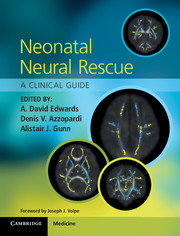Book contents
- Frontmatter
- Contents
- List of contributors
- Foreword
- Section 1 Scientific background
- Section 2 Clinical neural rescue
- Section 3 The future
- 18 Novel neuroprotective therapies
- 19 Combining hypothermia with other therapies for neonatal neuroprotection
- 20 Biomarkers for studies of neuroprotection in infants with hypoxic–ischaemic encephalopathy
- Index
- References
18 - Novel neuroprotective therapies
from Section 3 - The future
Published online by Cambridge University Press: 05 March 2013
- Frontmatter
- Contents
- List of contributors
- Foreword
- Section 1 Scientific background
- Section 2 Clinical neural rescue
- Section 3 The future
- 18 Novel neuroprotective therapies
- 19 Combining hypothermia with other therapies for neonatal neuroprotection
- 20 Biomarkers for studies of neuroprotection in infants with hypoxic–ischaemic encephalopathy
- Index
- References
Summary
Introduction
This chapter will review the evidence for selected novel neuroprotective therapies, providing background information, in vitro and in vivo data for safety, efficacy, clinical feasibility and where available, a review of clinical studies. Examples of growth factors (erythropoietin), cell-based therapies and inhaled agents (xenon) will be discussed. We aim to give an overview of therapies that may be added to our armamentarium in the next decade. Ideally, in the future, the approach to neuroprotection will be integrated, with combined therapies timed to target specific mechanisms of injury and repair.
Introduction
Erythropoietin (Epo) is a 34-kDa glycoprotein originally identified for its role in erythropoiesis, but which has since been found to have other functions. During embryologic and fetal development, Epo receptors (EpoR) are widespread [1] and Epo appears to have trophic effects on the vascular and nervous systems among others [2,3]. As the fetus develops, EpoR become increasingly regionally and cell-specific [4]. The nonhaematopoietic function of Epo as it interacts with these receptors has been the subject of extensive investigation over the past 15 years. In particular, the neuroprotective effects of Epo and the mechanisms by which these effects occur have been researched in experimental paradigms ranging from cell culture to knockout mice, to small and large animal models of brain injury.
- Type
- Chapter
- Information
- Neonatal Neural RescueA Clinical Guide, pp. 195 - 207Publisher: Cambridge University PressPrint publication year: 2013



